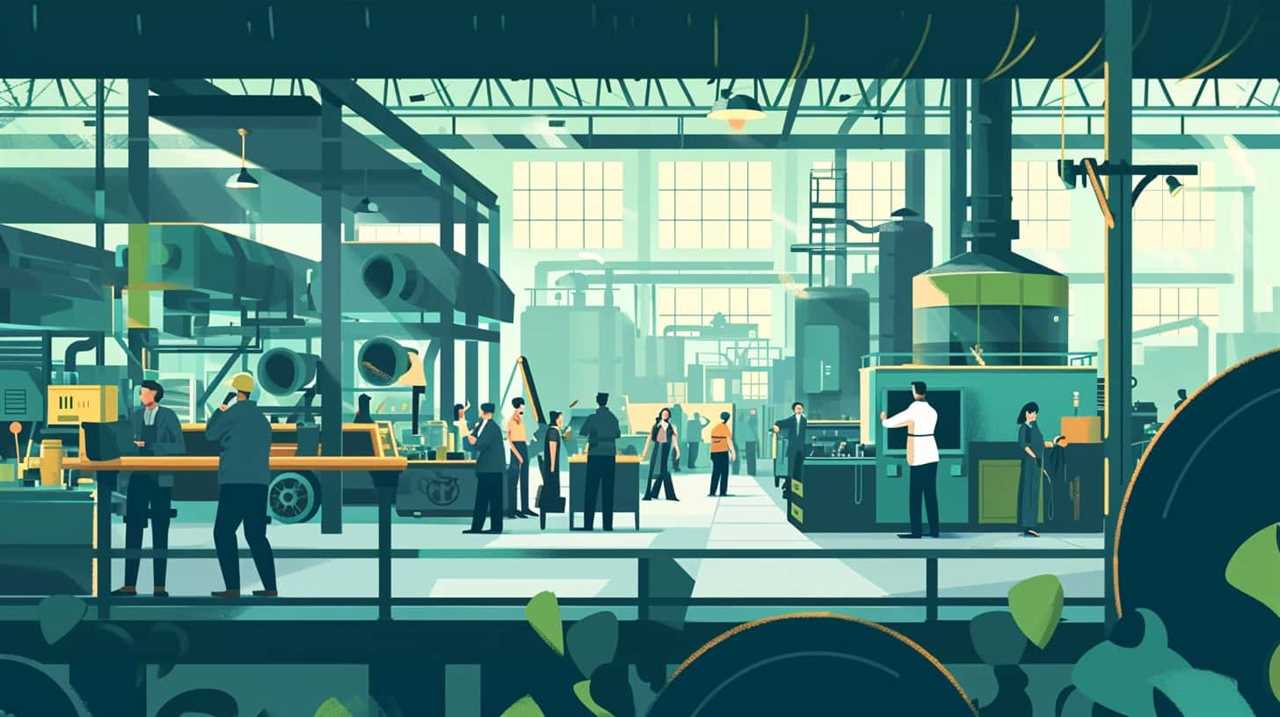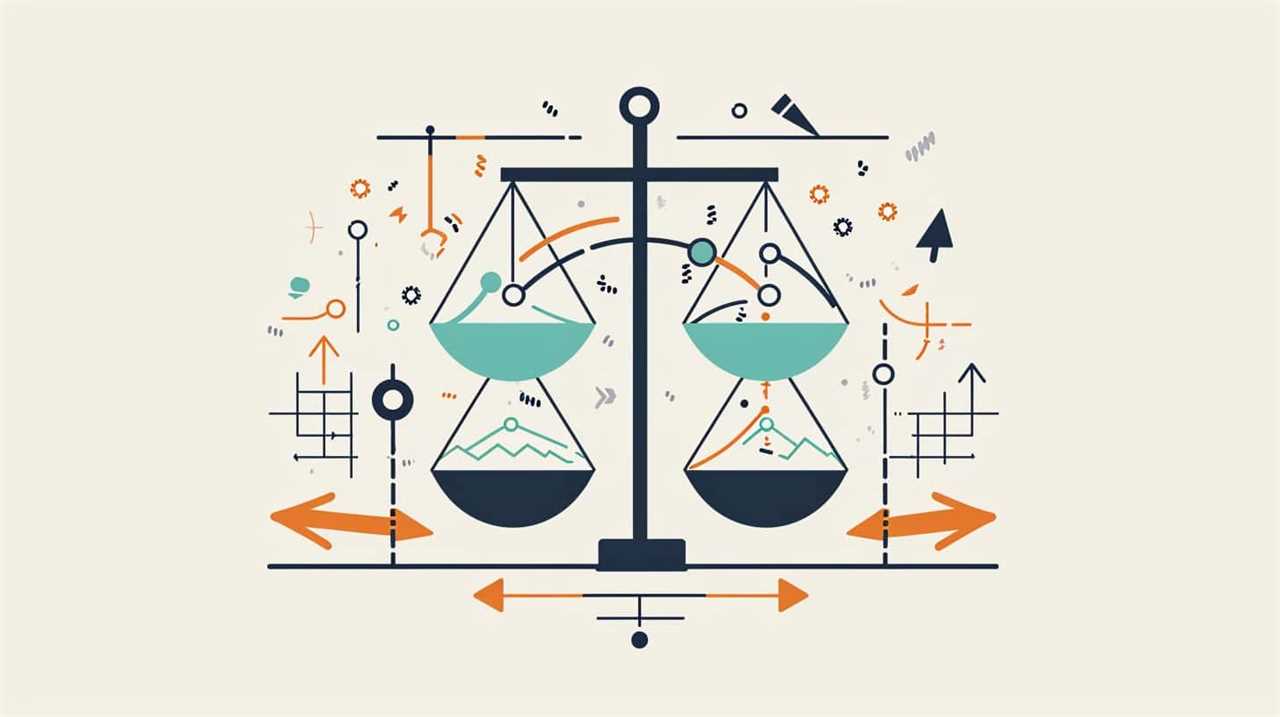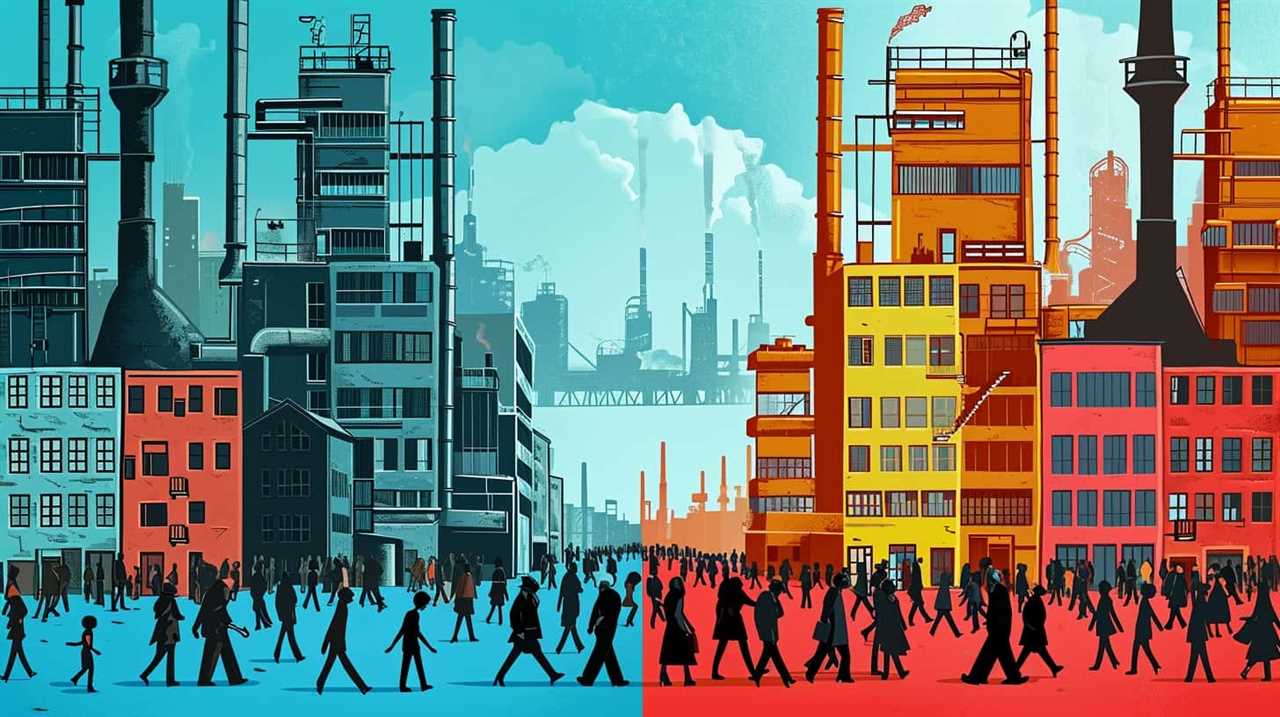Welcome to ‘Keynes Versus Monetarism: Economic Theories Unveiled.’
In this exploration, we will delve into the fascinating world of economic theories and shed light on the clash between two influential schools of thought: Keynesian economics and monetarism.
You might not know that these theories have shaped economic policies and influenced our understanding of how economies function.
Through this journey, we aim to provide you with a fresh perspective on these theories, uncover their key concepts, and reveal their impact on economic stability.

So, if you’re an audience seeking innovation and a deeper understanding of economic principles, join us as we unravel the complexities and nuances of Keynes versus monetarism.
Key Takeaways
- Keynesian Economics prioritizes government intervention to stimulate aggregate demand and stabilize the economy.
- Monetarism emphasizes the role of money supply in influencing economic activity and focuses on controlling money supply for stable economic growth.
- The Quantity Theory of Money, advocated by Friedman, states that changes in the money supply have a direct and predictable effect on prices and inflation.
- Keynesian theory advocates for government intervention during economic instability, while monetarists argue for a limited government role and focus on monetary policy.
Keynesian Economics: an Overview
In Keynesian economics, we prioritize government intervention to stimulate aggregate demand and stabilize the economy. The role of government is seen as crucial in influencing economic outcomes through its ability to control fiscal and monetary policies. Keynesian economists argue that when there’s a deficiency in aggregate demand, the government should step in to increase spending, either through direct investment or by implementing expansionary fiscal policies, such as tax cuts or increased government expenditure. By doing so, the government aims to boost consumer and business spending, which in turn leads to an increase in aggregate demand. This approach is based on the belief that changes in aggregate demand have a significant impact on economic growth and employment levels.
In contrast to other economic theories, Keynesian economics emphasizes the importance of government intervention in managing aggregate demand and supply. It recognizes that the private sector alone may not always be able to generate sufficient demand to fully utilize the economy’s productive capacity. Therefore, government actions become necessary to bridge the gap and ensure overall economic stability. Keynesian economists also emphasize the need for countercyclical policies, meaning that during periods of economic downturns, the government should increase spending to stimulate demand and prevent a further decline in economic activity. Conversely, during periods of high inflation or overheating, the government should adopt policies to reduce aggregate demand and control inflationary pressures.
Monetarism: Understanding the Basics
When it comes to understanding monetarism, there are three key points to consider.

First, monetarism places a strong emphasis on the role of money supply in influencing economic activity.
Second, it suggests that inflation is primarily caused by an excessive growth in the money supply.
Lastly, monetarism has had a significant impact on monetary policy, advocating for a focus on controlling the money supply to achieve stable economic growth.
Role of Money Supply
We analyze the role of money supply in Monetarism and its basic principles. Monetarism, as an economic theory, emphasizes the importance of money supply in determining the level of economic activity and inflation. According to Monetarists, changes in the money supply have a direct impact on the overall economy. They argue that government intervention in the form of controlling the money supply can help stabilize the economy and control inflation. Monetarists follow the Quantity Theory of Money, which states that changes in the money supply lead to proportional changes in the price level. By controlling the money supply, policymakers can influence interest rates, investment, and overall economic growth. The table below summarizes the key principles of Monetarism:

| Principles of Monetarism |
|---|
| Money supply affects the economy |
| Government intervention can stabilize the economy |
| Quantity Theory of Money |
| Control of money supply influences interest rates and investment |
| Economic growth can be controlled through monetary policy |
Inflation and Monetarism
Our understanding of inflation and its relationship with Monetarism is crucial in unraveling the basics of this economic theory. Monetarism posits that inflation is primarily caused by excessive growth in the money supply. According to Monetarists, when the government increases the money supply at a faster rate than the growth in the economy, it leads to inflation. They believe that controlling the money supply is the key to controlling inflation and achieving economic stability.
Monetarism also suggests that there’s a trade-off between inflation and unemployment. It argues that reducing inflation through monetary policy can lead to higher levels of unemployment in the short run, but in the long run, it promotes economic growth. Therefore, Monetarists advocate for a stable and predictable growth in the money supply to maintain low inflation and foster economic prosperity.
Impact on Monetary Policy
Monetarism’s impact on monetary policy is significant in shaping economic stability and growth.
One of the key areas where monetarism influences monetary policy is in the determination of interest rates. According to monetarist theory, changes in the money supply have a direct impact on interest rates. This is because an increase in the money supply leads to an increase in demand for goods and services, which in turn leads to an increase in the demand for credit. As a result, interest rates rise to balance supply and demand in the credit market.

Central banks play a crucial role in implementing monetarist policies by controlling the money supply through open market operations and setting interest rates accordingly. By influencing interest rates, central bank actions can have a profound effect on the overall economy, promoting stability and growth.
Milton Friedman’s Perspective on Money Supply
Friedman’s perspective on money supply plays a crucial role in understanding monetarism. He advocated for a strict control of the money supply as the key driver of economic stability and growth.
According to Friedman, an increase in the money supply leads to inflation, while a decrease causes deflation.
However, Keynesian economists critique this view, arguing that the focus on money supply neglects other important factors that influence the economy.

Friedman’s Monetary Policy
One important aspect of monetary policy is the control of money supply, which plays a crucial role in shaping the overall economy. Friedman’s monetary theory, known as monetarism, emphasizes the impact of monetary policy on economic stability and growth.
Here are two key points to consider:
- Quantity Theory of Money: Friedman argued that changes in the money supply have a direct and predictable effect on prices and inflation. According to his theory, increasing the money supply too rapidly leads to inflation, while reducing it too quickly can cause deflation.
- Central Bank Independence: Friedman advocated for the independence of central banks in controlling the money supply. He believed that political interference can lead to poor monetary policy decisions and hinder economic stability.
Money Supply Influence
As economists, we understand the crucial role of money supply in shaping the overall economy. According to Friedman, changes in the money supply have a direct impact on inflationary pressures in the economy. He argued that excessive increases in the money supply lead to inflation, while decreases in the money supply result in deflationary pressures.
Friedman believed that the key to controlling inflation and maintaining price stability lies in the implementation of effective monetary policy. He advocated for a steady and predictable increase in the money supply, typically at a rate equal to the growth of the economy. This approach, known as monetarism, aimed to provide a stable monetary framework for economic growth and stability.

Keynesian Critique on Monetarism
From our perspective as economists, we can now turn our attention to the Keynesian critique of monetarism regarding the perspective on money supply. The Keynesian perspective challenges the Monetarist approach, particularly Milton Friedman’s perspective on money supply.
Here are two key points to consider:
- Keynesian critics argue that the Monetarist approach oversimplifies the relationship between money supply and economic output. They contend that factors such as expectations, animal spirits, and liquidity preference play a crucial role in determining aggregate demand.
- Additionally, Keynesians emphasize the importance of fiscal policy in stabilizing the economy. They argue that monetary policy alone, as advocated by Monetarists, is insufficient to combat recessions and achieve full employment.
With these critiques in mind, we can now delve into the role of central banks in monetarism, which further highlights the differences between the Keynesian and Monetarist perspectives.
The Role of Central Banks in Monetarism
In monetarism, central banks play a vital role in controlling the money supply and influencing the economy. Central bank independence is a key aspect of monetarism, as it allows the central bank to make monetary policy decisions without political interference. This independence enables central banks to focus on maintaining price stability and promoting economic growth.

Central banks have a range of monetary policy tools at their disposal to achieve their objectives. These tools include open market operations, reserve requirements, and the discount rate. Open market operations involve buying or selling government securities to control the money supply. By adjusting reserve requirements, central banks can influence the amount of money that commercial banks can lend. The discount rate is the interest rate at which commercial banks can borrow from the central bank, and changes to this rate can impact borrowing costs and credit availability.
Through the use of these tools, central banks can effectively manage inflation, stabilize financial markets, and promote economic stability. Their role in monetarism is crucial in ensuring that the money supply is controlled and that the economy remains on a sustainable growth path. By maintaining independence and utilizing appropriate monetary policy tools, central banks are able to contribute to a stable and innovative economic environment.
| Monetary Policy Tools | Description |
|---|---|
| Open Market Operations | Buying or selling government securities to control the money supply |
| Reserve Requirements | Adjusting the amount of money that commercial banks must hold as reserves |
| Discount Rate | The interest rate at which commercial banks can borrow from the central bank |
Inflation and Its Impact on the Economy
Inflation plays a significant role in the economy, acting as both a catalyst for economic growth and a potential source of instability.
On one hand, moderate inflation can stimulate consumption and investment, driving economic expansion.

On the other hand, high or unpredictable inflation can erode purchasing power, increase production costs, and create uncertainty, negatively affecting businesses and consumers.
Understanding the impact of inflation is crucial for policymakers and economists in formulating effective monetary and fiscal policies to maintain a stable and sustainable economy.
Inflation: Economic Growth Catalyst
Our analysis reveals that a moderate level of inflation can serve as a catalyst for economic growth. Inflation, as a measure of the increase in the general price level of goods and services, has the potential to stimulate economic activity in several ways:
- Encourages spending: When consumers anticipate future price increases, they’re more likely to make purchases sooner rather than later, boosting overall demand and stimulating economic growth.
- Enhances investment: Moderate inflation can incentivize businesses to invest in new projects and expand their operations, as they expect higher future prices and increased profits.
- Facilitates debt repayment: Inflation erodes the real value of debt over time, making it easier for borrowers to repay their loans and reducing the burden on the economy.
Central banks often employ inflation targeting as a monetary policy tool to maintain price stability and promote sustainable economic growth. By setting a target inflation rate, central banks can effectively manage inflation to optimize its positive impact on the economy.

Inflation: Stability or Instability?
A crucial consideration when evaluating the impact of inflation on the economy is its potential for stability or instability. Inflation, as measured by various indices such as the Consumer Price Index (CPI) or the Producer Price Index (PPI), can have significant implications for economic stability.
Governments and central banks often employ inflation targeting as a policy tool to maintain price stability and promote sustainable economic growth. By setting specific inflation targets, policymakers aim to strike a balance between fostering economic expansion and preventing runaway inflation. However, the effectiveness of inflation targeting as a tool for stability is a subject of ongoing debate among economists. Some argue that targeting inflation can lead to a more stable economic environment, while others contend that it can have unintended consequences and exacerbate economic instability.
Transitioning into the subsequent section about Friedman’s belief in the quantity theory of money, it’s important to explore alternative perspectives on the relationship between inflation and stability.
Friedman’s Belief in the Quantity Theory of Money
We believe that Friedman’s belief in the Quantity Theory of Money is a fundamental aspect of his economic theory. Friedman’s perspective on inflation, monetarism, and economic growth can be summarized as follows:

- Quantity Theory of Money: Friedman argued that changes in the money supply have a direct impact on inflation. He believed that inflation is primarily a monetary phenomenon, with the quantity of money being the main driver of price levels. According to Friedman, when the money supply increases faster than the growth rate of the economy, it leads to inflation.
- Monetarism: Friedman’s belief in the Quantity Theory of Money formed the basis of his broader economic theory known as monetarism. Monetarism emphasizes the importance of controlling the money supply to stabilize the economy. Friedman advocated for a steady and predictable growth rate of the money supply to ensure price stability and promote long-term economic growth.
- Economic Growth: Friedman believed that excessive inflation can hinder economic growth. According to him, high inflation rates create uncertainty and distort price signals, making it difficult for businesses and individuals to make rational economic decisions. By controlling inflation through managing the money supply, Friedman argued that economies can achieve sustainable and stable economic growth.
The Importance of Controlling Money Supply
Controlling the money supply is crucial for maintaining economic stability and promoting sustainable growth. As the central bank’s primary tool for managing the economy, monetary policy plays a vital role in controlling inflation and ensuring the effectiveness of the overall economic system.
One of the key reasons for controlling the money supply is to manage inflation. By regulating the amount of money circulating in the economy, central banks can prevent excessive price increases and maintain price stability. When there is an excess supply of money, demand for goods and services rises, leading to higher prices. Conversely, when there is a shortage of money, demand decreases, resulting in lower prices. Finding the right balance is essential to avoid inflationary pressures or deflationary spirals.
To illustrate the importance of controlling the money supply, let’s take a look at the following table:
| Monetary Policy | Effectiveness |
|---|---|
| Tightening | Controls inflation, but can slow down economic growth |
| Easing | Stimulates economic growth, but can lead to inflation |
| Neutral | Maintains stability, but may not address specific economic challenges |
By adjusting the money supply through various monetary policy tools such as interest rates, reserve requirements, and open market operations, central banks can influence borrowing costs, investment decisions, and overall economic activity. However, it is crucial to strike a balance between controlling inflation and supporting economic growth to ensure the effectiveness of monetary policy.

Monetarism’s Criticism of Fiscal Policy
Monetarism criticizes fiscal policy for its limited effectiveness in managing economic stability and promoting sustainable growth. While fiscal policy involves the use of government spending and taxation to influence the economy, monetarists argue that it has several limitations and criticisms:
- Crowding out effect: One of the main criticisms of fiscal policy is the crowding out effect. When the government increases its spending, it often finances it through borrowing, which can lead to higher interest rates. This, in turn, can reduce private investment and dampen economic growth.
- Time lags: Fiscal policy operates with time lags, meaning that the effects of changes in government spending or taxation may not be felt immediately. This delay can make it difficult to fine-tune the economy and react promptly to economic fluctuations.
- Political considerations: Fiscal policy decisions are often influenced by political considerations, making it susceptible to short-term thinking and electoral cycles. This can lead to inefficient allocation of resources and hinder long-term economic growth.
Despite these criticisms, fiscal policy remains an important tool in managing the economy. However, monetarism argues for a greater reliance on monetary policy, which focuses on controlling the money supply and interest rates to achieve economic stability and sustainable growth.
Transitioning into the subsequent section about Keynesian vs. Monetarist views on government intervention, it’s important to understand their differing perspectives on the role of fiscal policy in managing the economy.
Keynesian Vs. Monetarist Views on Government Intervention
One key difference between Keynesian and Monetarist economic theories lies in their views on government intervention in the economy.

Keynesians believe that government intervention is necessary and effective in stabilizing the economy, especially during times of recession or high unemployment. They argue that government spending can stimulate economic growth and increase aggregate demand.
In contrast, Monetarists are skeptical of the effectiveness of government intervention and emphasize the importance of monetary policy in influencing economic outcomes.
Keynesians argue that government intervention can have a positive impact on economic growth by providing fiscal stimulus through increased government spending or tax cuts. They believe that government spending can create jobs, boost consumer spending, and ultimately lead to higher economic growth. Additionally, they argue that government intervention can help stabilize the economy by mitigating the negative effects of business cycles.
On the other hand, Monetarists contend that government intervention can have unintended consequences and may hinder economic growth. They believe that excessive government spending can lead to inflation and distort resource allocation. Instead, Monetarists advocate for a limited role for the government and emphasize the importance of monetary policy in controlling inflation and promoting long-term economic stability.

In conclusion, Keynesians and Monetarists have divergent views on the effectiveness of government intervention and its impact on economic growth. While Keynesians argue for active government involvement to stimulate the economy, Monetarists advocate for a more hands-off approach, relying on monetary policy to achieve economic stability.
This sets the stage for our discussion on the relationship between money supply and interest rates.
The Relationship Between Money Supply and Interest Rates
In our discussion on the relationship between money supply and interest rates, we can observe how government intervention and monetary policy play a crucial role in shaping economic outcomes. The interaction between money supply and interest rates is a key aspect of monetary policy, as changes in the money supply can have a direct impact on interest rates and vice versa.
Here are two important points to consider:

- Money Supply and Bond Yields:
- An increase in the money supply can lead to lower interest rates, as there’s more money available for lending and borrowing. This can result in lower bond yields, making borrowing cheaper for individuals and businesses.
- On the other hand, a decrease in the money supply can lead to higher interest rates, as there’s less money available for lending and borrowing. This can result in higher bond yields, making borrowing more expensive.
- Impact of Interest Rates on the Economy:
- Changes in interest rates can have significant effects on economic activity. When interest rates are low, borrowing and spending tend to increase, stimulating economic growth.
- Conversely, when interest rates are high, borrowing and spending tend to decrease, which can slow down economic activity.
Understanding the relationship between money supply and interest rates is crucial for policymakers and economists in order to make informed decisions about monetary policy and its impact on the economy. By analyzing these dynamics, we can better understand how changes in the money supply affect interest rates and, ultimately, the overall health of the economy.
Monetarism’s Influence on Economic Policy
From our analysis of the relationship between money supply and interest rates, we can see that monetary policy plays a crucial role in shaping economic outcomes. Monetarism, as an economic theory, has had a significant impact on monetary policy and has provided valuable insights into the management of inflation and economic stability.
Monetarism, championed by economists such as Milton Friedman, emphasizes the importance of controlling the money supply to achieve stable economic growth. According to monetarist theory, excessive growth in the money supply leads to inflation, while a decrease in the money supply can lead to deflation. Therefore, monetarists argue that central banks should focus on controlling the money supply to maintain price stability.
Monetarism’s view on inflation is that it’s primarily a monetary phenomenon, caused by an excess supply of money relative to the demand for goods and services. To combat inflation, monetarists advocate for a conservative approach to monetary policy, with a focus on controlling the growth rate of money supply.

Furthermore, monetarism highlights the importance of maintaining a stable and predictable monetary policy framework to promote economic stability. By providing clear guidelines and rules for monetary policy, monetarists believe that policymakers can reduce uncertainty and promote long-term economic growth.
The Monetarist Approach to Economic Stability
Our analysis reveals the monetary policy approach to economic stability championed by monetarism. Monetarists believe that controlling the money supply is crucial for maintaining stable economic growth. They argue that by managing the amount of money in circulation, policy-makers can influence interest rates and inflation levels, which in turn affect economic activity.
To understand the monetarist approach to economic stability, it’s important to consider the following:
- Monetary Policy Effectiveness: Monetarists emphasize the importance of monetary policy in stabilizing the economy. They believe that by adjusting interest rates and managing the money supply, central banks can effectively control inflation and stimulate economic growth.
- Interest Rate Management: Monetarists advocate for the use of interest rates as a primary tool for economic stability. They argue that adjusting interest rates can influence borrowing costs, consumer spending, and investment decisions, thereby affecting overall economic activity.
- Money Supply Management: Monetarists contend that managing the money supply is crucial for maintaining price stability and promoting economic growth. They argue that excessive money creation can lead to inflation, while a restricted money supply can hinder economic expansion.
Monetarism and its focus on monetary policy effectiveness have shaped economic thought and policy-making for decades. By emphasizing the control of money supply and interest rates, monetarists seek to provide a framework for achieving stable and sustainable economic growth.

Key Differences Between Keynesian and Monetarist Theories
To understand the key differences between Keynesian and monetarist theories, let’s delve into their contrasting approaches to economic stability and policy-making.
One of the fundamental distinctions lies in their views on the role of government intervention. Keynesian theory proposes that government intervention is necessary to stabilize the economy during times of recession or inflation. According to Keynes, during a recession, the government should increase its spending to stimulate aggregate demand, thus boosting economic activity. On the other hand, monetarists argue for a more limited role for the government, advocating for the importance of monetary policy in maintaining economic stability. They believe that the government should focus on controlling the money supply and ensuring price stability, rather than actively manipulating aggregate demand.
Another key difference between the two theories is their impact on economic stability. Keynesian theory emphasizes the importance of managing aggregate demand, as fluctuations in demand can lead to economic instability. By using fiscal policy tools such as government spending and taxation, Keynesians aim to stabilize the economy and reduce unemployment.
Monetarists, on the other hand, believe that fluctuations in the money supply are the primary driver of economic instability. They argue that by controlling the money supply through monetary policy, the government can maintain price stability and prevent inflation or deflation.

Frequently Asked Questions
How Did Keynesian Economics Influence Government Intervention in the Economy?
Keynesian economics greatly influenced government intervention in the economy by emphasizing the importance of government spending and fiscal policies to stimulate economic growth and stabilize the business cycle.
What Are the Main Criticisms of Monetarism Towards Fiscal Policy?
The main criticisms of monetarism towards fiscal policy revolve around its effectiveness in stimulating economic growth and addressing unemployment. Some argue that it lacks the necessary flexibility and precision to respond to changing economic conditions.
How Does the Monetarist Approach to Economic Stability Differ From Keynesian Theories?
The Monetarist approach to economic stability differs from Keynesian theories in its emphasis on controlling money supply and inflation, while Keynesian theories focus on government intervention and fiscal policy to manage aggregate demand and stabilize the economy.
What Is Milton Friedman’s Perspective on the Role of Central Banks in Controlling Money Supply?
Milton Friedman’s perspective on central banks emphasizes their crucial role in controlling money supply. He believes that the central bank should maintain a steady growth rate of money to ensure economic stability and avoid inflationary pressures.

How Does Inflation Impact the Economy According to the Monetarist Perspective?
In the monetarist perspective, inflation is seen as harmful to the economy. It erodes the purchasing power of money, distorts price signals, and leads to resource misallocation, ultimately hindering economic growth and stability.
How Has Keynesian Theory Influenced Modern Economic Thought?
Keynesian theory legacy modern economics can be seen in government intervention during economic downturns, as Keynes advocated for. The idea of fiscal policy to stimulate demand and smooth out business cycles is still prevalent in modern economic thought. Keynes’s emphasis on consumer and business confidence also remains influential in economic policymaking.
Conclusion
In conclusion, while both Keynesian economics and monetarism have their merits, it’s essential to find a balance between the two theories in order to achieve economic stability and growth.
As the saying goes, ‘Don’t put all your eggs in one basket.’ By considering the insights from both perspectives and adapting policies accordingly, governments and central banks can better navigate the complexities of the economy and ensure long-term prosperity for their nations.
Lauren’s talent in writing is matched by her passion for storytelling. Her love for books and deep understanding of culture and entertainment add a distinct flavor to her work. As our media and press contact, Lauren skillfully bridges the gap between afterQuotes and the broader media landscape, bringing our message to a wider audience.










